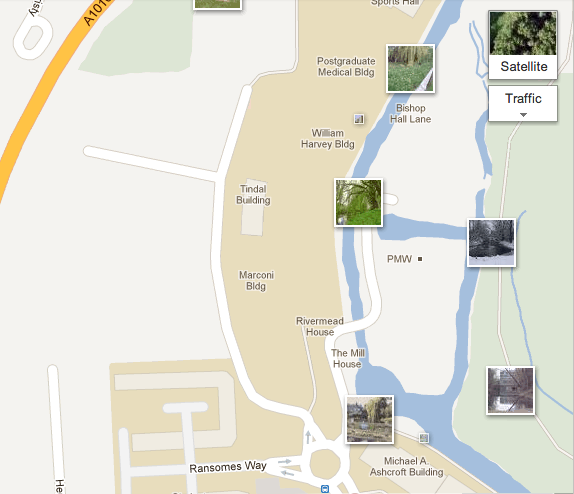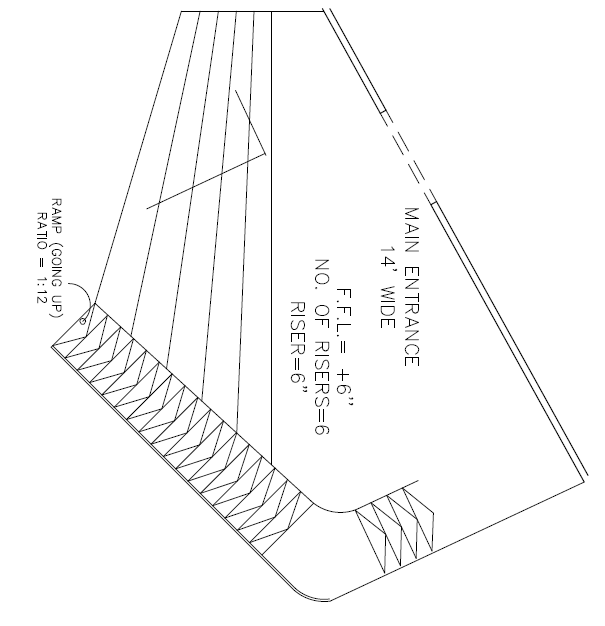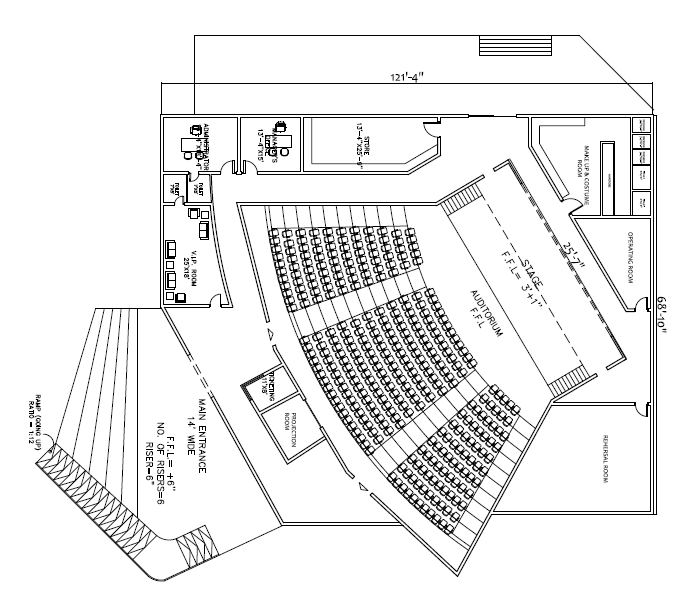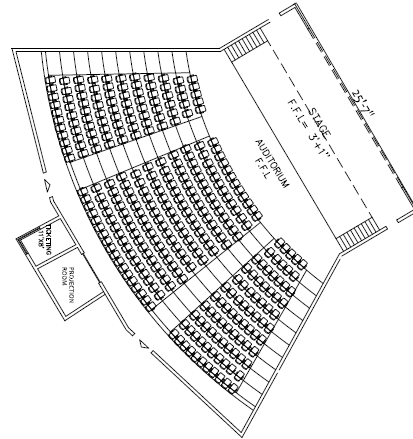
Flight Mechanics and Performance
January 28, 2021
Developing Strategies to Reduce Energy Consumption
January 28, 2021Introduction
Careful planning and organization are always required for designing the learning and teaching spaces. The procedures require an intimate collaboration of architects, lighting designers, mechanical engineers, instructors, electrical engineers and specialists for audio-video facilities.
Carefully coordinated information gathered from engineering and architectural activities can result in a well designed and useful learning space. The basic purpose of this paper is to present the design of an auditorium hall of the university behind the Marconi building of the university.
Need Help with Academic Writing? Get a Response within 24 Hours!
Planning of space and layout
Objectives
Auditorium halls are the places for personal and social interactions where creative thinking is encouraged through the learning festivals i.e. sports and other events. The achievement of the best architectural elements through the best suitable arrangements of the learning and entertainment facilities is the primary objective of the design.
A balanced relationship between construction, audio-video disciplines and architectural skills are required to design the auditorium hall. The optimization of the available space is required by the identification of the performance requirements of the structure and needs in the design stage. The support spaces of ancillary within the auditorium can be provided through the infrastructure of the building. The designed structure should be used for a variety of purposes; the architectural elements are required to dictate the best possible use of the design.
Ceremony Halls – General requirements
The auditorium or ceremony halls are usually designed to serve a single function with fixed seating, inclined floor and writing furniture. An unobstructed and clear view is required for each seat to the stage or the presentation wall. For best visual communication the structure is required to be well equipped.
Location
The auditorium is located at the point which provides easy access to the students and for the delivery of equipment. The building is isolated from the noisy places and gives a perfect floor for the various types of gatherings i.e. sports, exams or convocations.
The distracting sounds and noises are avoided by the careful selection of the adjacent spaces i.e. makeup and costume, administration, toilet, store, VIP room etc. The location of the building has been selected while considering the air paths and their relation to the exterior environment.
The flow of the students in and out of the building is taken into account (Abowd et.al, 2000). The hall has been designed by keeping in mind the factors that affect the student’s participation in the numerous activities and variety of events. The configuration of the spaces where the extensive media is required to be used is an important factor that ensures a clear and effective display system. As illustrated in the figure the auditorium hall of the university will be located behind the Marconi building of the university (Argyle and Cook, 1976).

Figure 1: Location of the hall
Entrances
The location of the entrance has been determined by considering the flow of the students. The main entrance is made at the back of the hall. The sizes of the exits and entrances are defined by considering the student flow along with the building codes. The design of the exterior paths, corridors, entrances and exits has taken into account the student traffic going in and out of the hall. A completely vacant room cannot be assumed during festivals and sports events. Vision panels are provided in the entrance door which can be tinted (Bransford et.al, 2000). The wall surface can be protected by providing door stops.

Figure 2: Main entrance
Seating arrangement, visibility and location of aisles
The floor of the auditorium is required to be raked in such a way that it provides a clear view to the occupants of each seat and the stage. The floor can be tied for the provision of a seating rake. The height for each step or tier can be made up to 6”. For the steeply raked floors, a slight tilt of the front row will be required backwards that can compensate for the vertical viewing angles to the stage. To preserve the best view from all seats, the centre aisles can be avoided. However, their location can be determined through the considerations of the sightlines and the good access requirements to the rows and the stage (Buxton, 1997).
The capacity of the seating is calculated by dividing the whole area of the audience by the average seat area occupied by each seat which is about 0.5 m2, or 5.38 ft2. The area of the two front rows is about 1200 ft2. And the two back areas is about 1500 ft2. Where the balcony area is 1950 ft2, the total capacity will be.
For the improvement of the visibility, each row of seats is required to be offset by the distance of one-half width. To provide better access to the students to the seating, cross aisles will be used in this design.

Figure 3: Complete design
Seating
Dimensions of the hall are selected to accommodate the programmed number of candidates with the provision of additional space to perform other activities i.e. audio-visual facilities, circulation space and free space for students to move easily. The seats are not fixed and can be removed while using the hall for sporting and extracurricular activities.
Stages and lectern
A standard lectern design will be used in the auditorium structure. The stage will be installed with dimensions 0.95m in height and 7.8m in width. The stage will be equipped with sufficient lighting, an area for the presenter and microphones. The stage will be designed to meet all of the electrical regulations. The stage will be provided with hinged doors for the direct entrance. Internal fittings and other electronic packages including computers, visual screens etc are also required for direct access (Barron and Michael, 1998).

Figure 4: Stage and seating
The lectern will be equipped with the expected facilities including lightning, microphones, notes for the commentators etc. A control panel with push buttons and touch screens will be available with computer monitors and installed systems. One section of the stage will be equipped with computer systems and interfaces through switching systems.
The link cables for video and audio systems, power outlets, telephone, LAN connections and data link cables will also be provided through infrastructure. Considering the spatial sense the design of the stage is standardized to match the aesthetics and directions of the design effectively. The lectern provided on the stage will have a flexible height adjustment function which will accommodate the users of wheelchairs and short stature personnel easily (Beranek and Leo, 1962).
The audio-video and electrical wiring will be carried through the trench going under the floor. A compartment will be provided within the trench for the presentation of the different features. The position of the lectern will be adjusted according to the position of the projection screens. The electrical regulations must meet the stage requirements. The electronic packages along with the internal fittings can be accessed through the removable access panels and hinged doors.
The installed equipment will require a continuous and sufficient ventilation system. The dual fans with computer grades are required to be installed with controlling speeds. The electrical contractors are responsible for defining the power appliances and wiring. The light of the lectern will be considered as a standardized unit that will be provided by the university. For portable computers, standard graphics with the standard outlets of the power supply are required (Cline, 1967).
The audio-video key locks will be used to assure the security of the access panels and lectern doors. For the improvement of the security of the equipment, the appliances can be screwed with the carcass of the lectern. The tamper-proof screws will be used to fix the microphones with the platen (Hawkes. 1971). A well-damped and rigid structure has been conceived by a careful selection of the design standards.
Floor, Walls, and Ceilings
The lay-in ceiling will be used with tiles of 2’ x 2’ dimensions. The finishes colour will be neutral on fixtures and furniture. The colour that can be easily changed and maintained will be preferred i.e. accent colours.
Orientation
The transformation of the sound from the source to the rear end of the hall is dependent upon the good orientation of the structure. Each wall surface, floor finish and ceiling plane has been given careful considerations for its configuration.
To provide the perfect sightline the floor has been tiered. The section of the ceiling above the sending end has been made to be inclined towards the seating area; however, it is inclined upward from the sending area. Such ceiling orientation will help the commentator’s voice to be delivered effectively towards the rear of the auditorium (Kay, 1977).
Noise control
Among other design factors, noise control is a major factor to be considered. The vending machines are required to be located as far as possible to avoid the generation of noise. The containers of recycling the trash must be located near the vending machines. The restrooms are designed for the faculty and other organizing members nearby the hall which also depends upon a load of hall per event.
Safety and Security
Emergency Lighting and Exit Lighting
Considering the placement and selection of fittings the design of emergency lights will be selected according to the structure requirements. The engineering and architectural services are required to perform such designs. The managing team will define the appropriate system of emergency lighting and their type. The maintained type of light fittings will be preferred at exits. However, the systems of emergency light fittings are non-maintained type. The exit signs will be lettered in green colour with a black background.
Fire protection services
One of the mandatory safety requirements of the hall is fire protection. The fire alarms will be installed to alert the organizers and adopt safety measures.
Key locks
The key locks are required in halls including for main entry doors which can be keyed masterly according to the system of the university and are under the control of the supervisor of the auditorium, the audio and video facilities are required to be locked, the touch screen cover of the lectern, computer modules and projection rooms are also required to be locked. For the service access of the audio-video facilities, the locks are required for the technicians only. The storerooms are separate and are lockable which can be used for the storage of the loose items including microphones, equipment related to the audio-video services, extra tables, chairs, sundry items, projectors and their trolleys (Wilson, 1989).
HVAC Controls
The motion detectors will be fitted within the hall to notice the user call for the requirement of ventilation. HVAC control will not be available for the direct use of the visitors.
Supply of fresh air
The variable speed fans will be installed for the continuous supply of fresh air to the hall. The fans will allow varying the volume of air according to the requirements and the crowded occupants.
Equipment requirements
Equipment required for the hall used for examination purposes.
The tablet armchairs will be used to facilitate the students while sitting in the hall for examination.
Steel case series 9000 will be used for the work unit with dimensions including, 25" d x 60" l x 29" h; which will be finished to match standards of finish and other building furniture. The clearance provided within the chairs will be 27.5". Table lecterns can be provided if required for a particular purpose. Natural oak can be used or stained tables to match the architectural wood can be used.
Other equipment includes
- Transparency projector with high intensity i.e. 4000 lumens
- DVD players for displaying educational movies
- Video Projector(s)
- Telephone
- Tuner
- Document camera
- Lectern
- UPS which can be used sufficiently to accommodate computing equipment for atleast30 minutes
- Laserdisc
- Audio Cassette
- Audio CD
- PC
- Work stations or Unix
- MAC
- 35 mm slide projector (optional)
- 16 mm projector (optional)
- Video camera (optional)
- External inputs interface
- Installed sound system if >80
- Sound amplification if >80
- Projection screens with minimum screen size 6' with according to the dimensions of the hall
The clocks can be installed working on the line voltage of 120v which have easy to read and large numerals which can be controlled centrally through a physical plant. The location of the clock will be such that it will be visible easily to the audience and the commentators on the stage (Wilson, 1989).
A phone will be provided to access the services of audio-video services, physical plant, the police of the campus and phone number of the campus.
For recycling trash and paper the receptacles will be provided.
References
- Abowd G., Atkeson C., Feinstein A., Hmelo C., Kooper R., Long S., Sawhney N., and Tani M. (2000). Teaching and Learning as Multimedia Authoring: The Classroom Project. Proceedings of ACM Multimedia pages 187-198
- Argyle M, and Cook M. (1976) Gaze and Mutual Gaze, Cambridge University Press, pp 216-245
- Bransford J., Brown A., and Cocking R. (2000), How People Learn: Brain, Mind, Experience and School, National Academy Press, pp 176-210
- Buxton W. (1997) Living in Augmented Reality: Ubiquitous Media and Reactive Environments, Video-Mediated Communication (edited by K. Finn, A. Sellen, and S. Wilbur), Lawrence Erlbaum Associates, pages 363-384
- Barron and Michael (1998), Auditorium Acoustics and Architectural Design, London: Routledge pp 618-628.
- Beranek A, and Leo L (1962) Music, Acoustics & Architecture. New York: John Wiley & Sons, Inc., pp 120-145
- Cline M (1967) The Perception of Where a Person is Looking, American Journal of Psychology, pages 41-50
- Hawkes, R. J (1971), Experience in Concert Auditoria, Acustica, Vol. 24, pp. 236-250.
- Kay, A. C (1977), Microelectronics and the Personal Computer, Scientific American, September, pp. 230-244.
- Wilson, C.E. (1989), Noise Control, Harper & Row Publishers, New York, pp 114-119
Get 3+ Free Dissertation Topics within 24 hours?


























